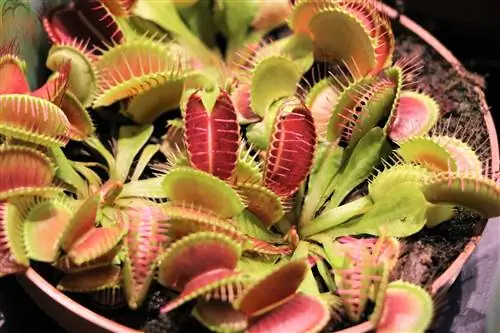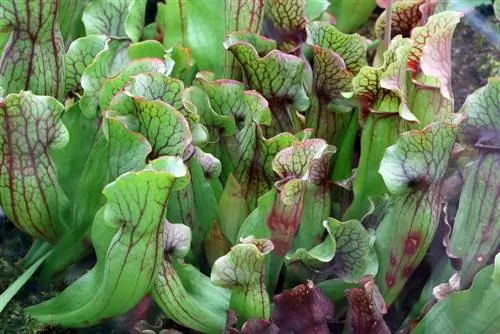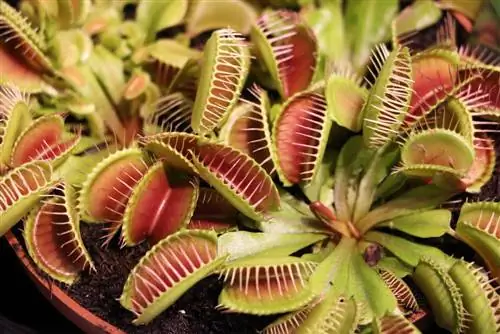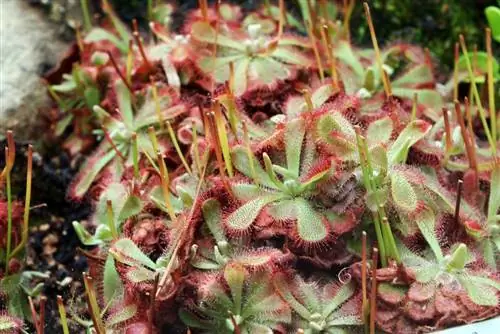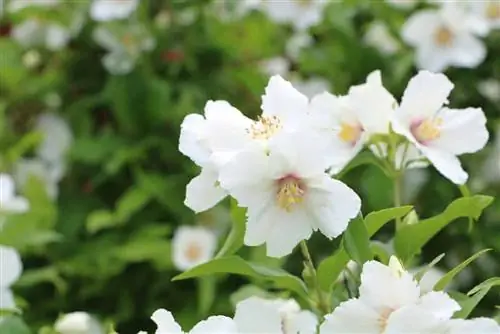- Author admin [email protected].
- Public 2023-12-17 03:39.
- Last modified 2025-06-01 06:48.
In reality, however, things look completely different, because carnivores have absolutely nothing in common with flesh-eating monsters. Although they get their nutrients primarily from small animals such as insects, they do not lead a murderous life of their own. With their fragrant secretions and bright flowers, they attract the animals and hold them in their adhesive, gripping, suction or traps before the secretion secreted by the plants decomposes them.
Known species of carnivorous plants
First of all, it must be made very clear that there are over 1,000 different species of carnivores worldwide, although only approx.15 species are also native to our latitudes. This results in a wide variety of species, which, depending on the plant species, catch insects and other small animals in their own way. The main species include:
- the Venus flytrap and also the most famous carnivorous plant
- the sundew
- the Sarracenia
- the Nepenthes
- the Pinguicula, also known as Butterwort
Useful tips for buying carnivores
Because the keeping of carnivorous plants is so special, it is relatively difficult to buy them. Although plant departments in hardware stores now have a fairly well-stocked selection of various carnivores, the conditions for keeping them are often lacking. It is therefore advisable to buy the plants directly in spring. The range is usually particularly diverse and you can assume that the plants will not suffer from being kept incorrectly for long. You can often observe that the carnivorous plants there are watered with tap water and are far too dry anyway. If the plants already look sickly, it's better not to buy them at all. Children particularly like the Venus flytraps because of their snapping traps. Unfortunately, closing the Venus flytrap requires an enormous amount of effort, so that the traps weaken and die after being closed several times. So you shouldn't necessarily irritate them!
Suitable location for carnivorous plants
Apart from Nepenthes species, carnivorous plants like it very sunny and can hardly get enough of it in the summer months. Most species come from fairly tropical areas and grow primarily on marsh-like and wet soils. Most species therefore cope well with waterlogging and also require high humidity. They are therefore best kept in greenhouses.
However, carnivores can also be kept indoors. Depending on the species, however, a particularly sunny place is recommended, ideally in a large glass or aquarium in order to be able to maintain the humidity better. Although many species don't mind low humidity, others are very sensitive to it.
Keeping conditions for carnivores
Since almost all carnivores grow on moorland, the substrate should also be adapted to the plants. If you want to repot the carnivorous plants, you need moor or peat. This substrate is particularly low in nutrients and is acidic with a pH value of 3.5. Due to their adaptation to their environment, carnivorous plants can hardly absorb nutrients through their roots. Plant species such as the Pinguicula or the sundew only need very little soil because they only develop very small and short roots. However, other carnivorous species such as Nepenthes or Sarracenia already form larger root balls. Except for Nepenthes species, carnivores like waterlogging. Every now and then you can let the substrate air out a little, but it shouldn't dry out. Most species are tough, after all they are used to being in the moor due to their natural environment. However, it is advisable to use rainwater or distilled water when watering, as even tap water contains many nutrients and minerals that carnivorous plants cannot cope with in the long term. The plants especially cannot cope with hard water.
Fertilize carnivorous plants
As already mentioned, carnivorous plants hardly absorb any nutrients through the water or substrate due to their adaptation to the environment, so fertilizer is also unnecessary. Carnivores get their nutrients from the insects they catch. This isn't a problem outdoors or in a greenhouse, because that's where small insects swarm. If the carnivores are in apartments that are sealed with fly screens, you can do them a favor every now and then with a mosquito or fly.
How to Prune Carnivorous Plants
Here, too, it all depends on the plant in question, although there are basic rules of thumb. If a trap or a leaf is dying, it can be cut back. The dying parts of the plant only draw unnecessary energy from the plant, so they can be cut off without hesitation. Some plant species, such as the Venus flytrap, show significant discoloration on the traps, especially in autumn, which then only looks sickly. The large traps in particular can then be cut back significantly so that the energy can be put into forming new traps in the spring. The behavior is similar in other species too.
Important tips for wintering
Once the carnivores are adjusted to winter and pruned through the fall, not much else usually happens. However, most species do not like frost! Locations that are cold and bright are good for overwintering. Carnivorous plants in the greenhouse can overwinter there without any concerns. Indoor plants are in good hands in the cool stairwell by the window. Unlike in summer, the plants should now be moist, but not waterlogged. It is enough to water the plants at regular intervals and keep the substrate moist.
What you should know about carnivorous plants in brief
- Most carnivorous plants require large amounts of light - many want full sun.
- For this reason, it is also a good idea to set up a brightly lit terrarium.
- The green roommate also doesn't need normal potting soil, but usually a peat-sand mixture.
If you have now found an optimal place and prepared an optimal bed for the plant, good starting conditions have already been created. But the next trap is already waiting: We have heard that carnivores come from bogs and swamps and therefore need a lot of water. According to the instructions, you always leave a few centimeters of water in your saucer, and our favorite still shrinks after a few weeks. Just why? - He was irreparably damaged by the calcium in the tap water!
- For this reason, only distilled or deionized water may be used for watering.
- Rainwater is also suitable with reservations.
- When it comes to humidity, most species require a constantly high level.
- In the terrarium it is usually between 50 and 90%.
- To avoid mold formation, however, you should not hermetically seal the terrarium.
Editor’s Tips
Basically, before buying a species, you should find out about the exact requirements of the species. As a beginner, it is advisable to limit yourself to simple cultures. Robust species such as Pinguicula hybrids are recommended here. A bright place and plenty of water are enough for this. Winter rest in a special location is not necessary, but watering is almost allowed during winter rest. The sundew species are somewhat more demanding. Lime-free water is mandatory for these plants.
Utricularia species should be kept in exactly the same way. They like it warm, humid and wet all year round and have good light, but no direct midday sun. The species from the Sarracenia family are also relatively easy to handle. In addition to lime-free water, they also need a cool place to rest in the winter (cool location, such as an unheated stairwell). As does the Drosera binata. With all the types mentioned so far, success is almost guaranteed, even on the windowsill. The very popular Venus trap requires a little more effort. It requires increased humidity of 50 to 70% (normal room air 40 to 60%). This means it can just about be kept on the windowsill. Since the plant wants a lot of sun, a place outside is recommended.
Learn more about the topic: Venus flytrap care, pitcher plant, overwintering.

